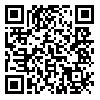Volume 27, Issue 2 (Summer 2023)
jwss 2023, 27(2): 255-268 |
Back to browse issues page
Download citation:
BibTeX | RIS | EndNote | Medlars | ProCite | Reference Manager | RefWorks
Send citation to:



BibTeX | RIS | EndNote | Medlars | ProCite | Reference Manager | RefWorks
Send citation to:
Feizi Z, Ranjbar fordoee A, Shakeri A. The Effect of Nanocellulose Content in Hydrogel Nanocomposites on the Strength of the Crusts (Case Study: Sand Dune Sample of Abuzidabad Siazgeh Desert). jwss 2023; 27 (2) :255-268
URL: http://jstnar.iut.ac.ir/article-1-4276-en.html
URL: http://jstnar.iut.ac.ir/article-1-4276-en.html
Kashan University , aranjbar@kashanu.ac.ir
Abstract: (3375 Views)
Maintaining soil structure and stability is essential, especially in arid and semi-arid regions with poor soil structural stability. Destruction of soil and its crust can cause wind erosion and desertification. The objective of this study was to investigate the effect of using hydrogel nanocomposite mulch on the stabilization of sand surfaces. A wind tunnel test was used to evaluate the erodibility of samples treated with different amounts of hydrogel nanocomposite. The compressive strength of the samples was measured by a manual penetrometer. The prepared nanocomposites were examined using scanning electron microscopy (FE-SEM), infrared spectroscopy (FTIR), and X-ray diffraction (XRD) images. The results of the wind tunnel showed that the addition of hydrogel nanocomposite to the samples improved the soil erosion rate by 100% at a speed of 15 m/s compared to the control sample. Bonding between sand particles by spraying hydrogel nanocomposites improves the erodibility of sand. Measurement of mechanical strength of treated samples after 30 days showed that the resistance of the crust increased with increasing the amount of nanocellulose in the composite, which can be expressed due to the increased surface area of the nanoparticle and the possibility of further bonding of the nanocomposite polymer bed with sand particles. While the crust diameter showed no significant difference with increasing concentration and the sample treated with nanocomposites containing 3% nanoparticles was thicker compared to other samples.
| Rights and permissions | |
 |
This work is licensed under a Creative Commons Attribution-NonCommercial 4.0 International License. |






